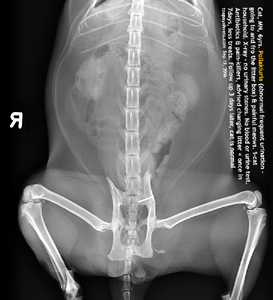Sunday Sep 9, 2018. DSH, MN, 8 years old
Sole cat in household. Stressed by new litter box and litter? Also moved house in Aug 2017.
Past 2 days, dysuria and pollakiuria (abnormal frequent urination). Today, I palpated distended bladder, the size of an orange. Need urinary catherisation. Does not want X-ray and blood test today. Urine test is mandatory this time to check for crystals.
Normal saline syringed to dislodge sand in mid-urethra. Irrigated bladder with 20 ml saline 5 x.
IV drip. Baytril antibiotics.
HISTORY
Dec 14, 2017 for dysuria. Blood test - low platelet. Recovered next day.
Sep 19, 2016. Urinary catherisation. Recovered. Blood test - low platelet. Advised feline C/D but not
X-rays
Urinary catheterisation to irrigate the bladder and suck out the sand
EVIDENCE
Dipstick evidence - pH 8, alkaline urine favours bacterial growth as compared to acidic urine.
Owner did not want blood test or X-ray
Explain X-ray of 2 years ago - no urinary stones
Blood test done on 2nd visit - pH alkaline
CONCLUSION
Prevent alkaline urine production. This alkalinity favours bacterial growth as compared to acidic urine. Special diet Feline C/D or feed canned food only. NO other dry pellets other than C/D.
















































